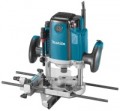The total power of the router, more precisely, the engine installed in it. The
higher this indicator, the more productive the device is, the better it copes with complex work, the more force on the cutter (torque) it provides during operation, and the greater the spindle speed can be (although a powerful tool is not necessarily high-speed). On the other hand, high power significantly affects the dimensions, weight and price of the tool, plus power consumption and network load increase accordingly. In addition, high torque in some cases (for example, with delicate processing) is frankly undesirable. Therefore, a tool should be chosen according to this parameter, taking into account the real needs and the specifics of the planned work.
There are three main categories of milling cutters in terms of power: light (up to 700 W), designed mainly for simple household work; medium (up to 1500 W), able to cope not only with domestic, but also with most professional tasks; and heavy (1500 W or more), used in cases where high power is critical. However, this gradation is true only for routers (see "Type"), other varieties have their own specifics: for example, lamellar models, in principle, do not need high power.

